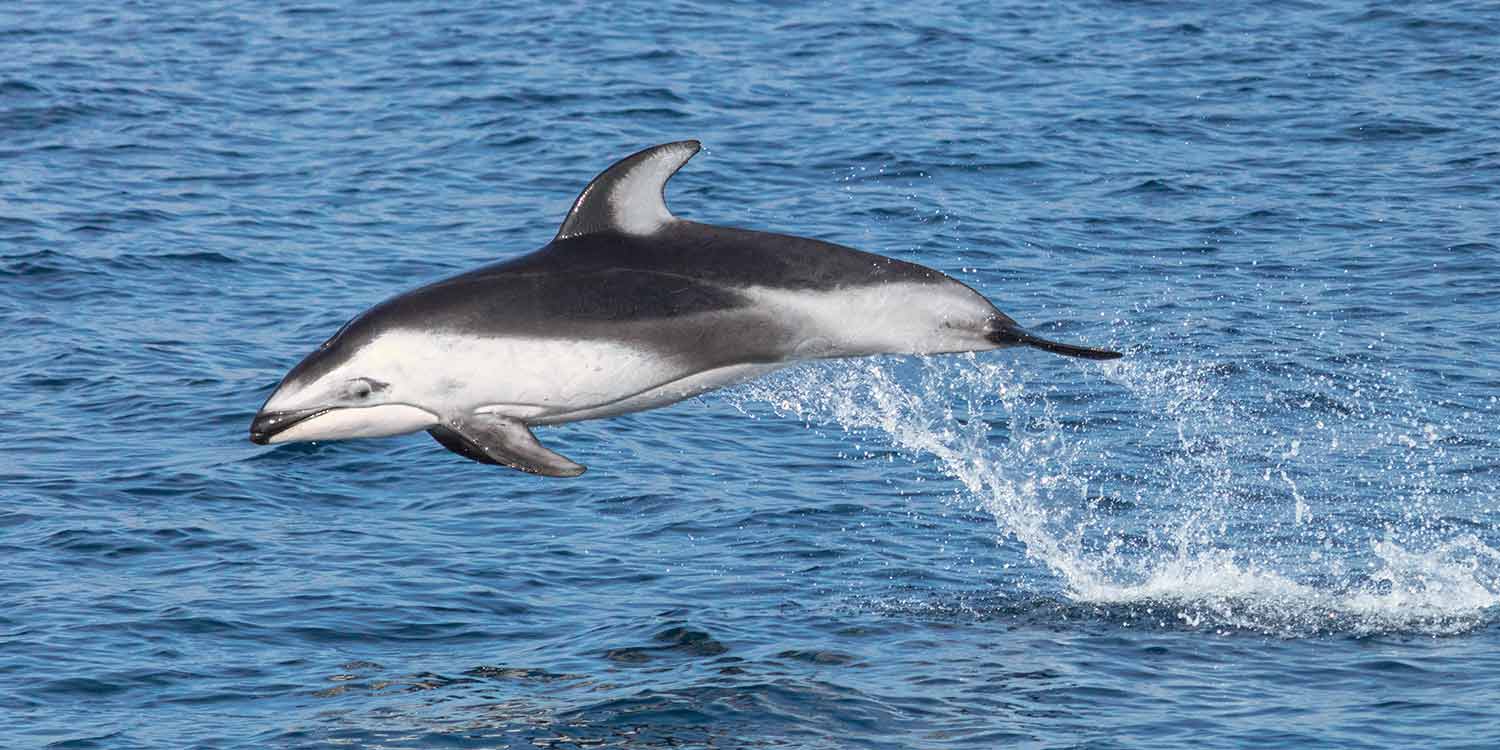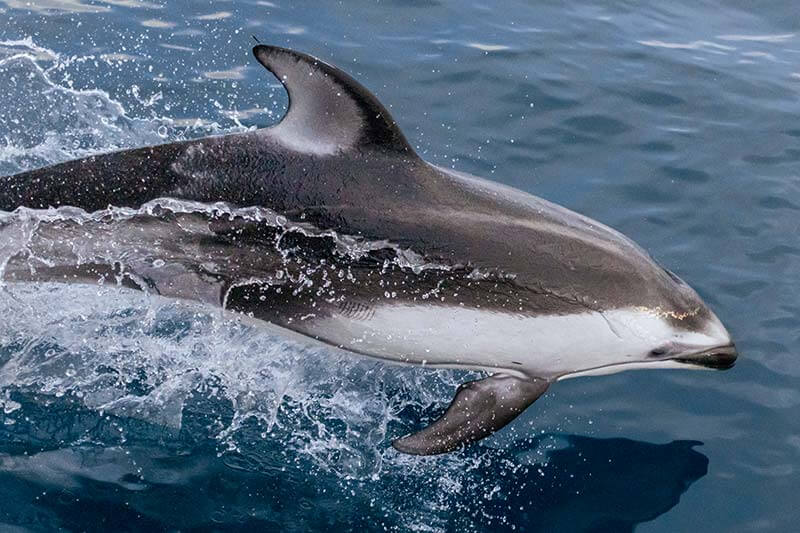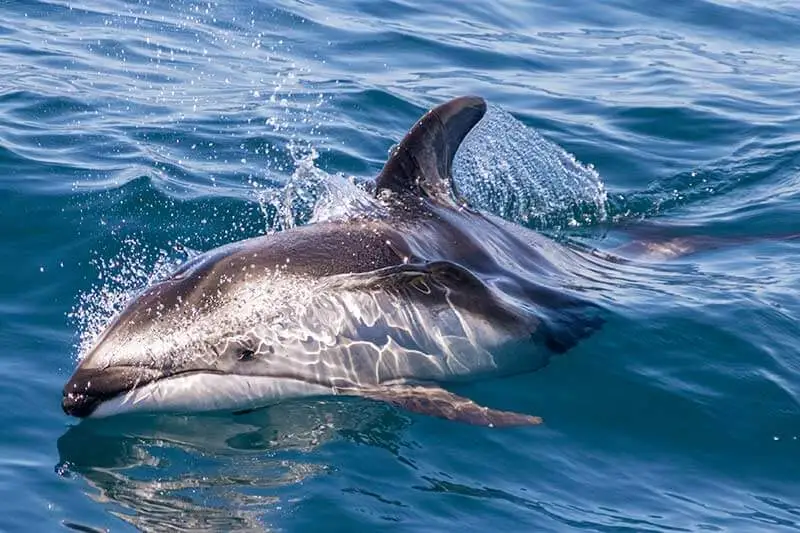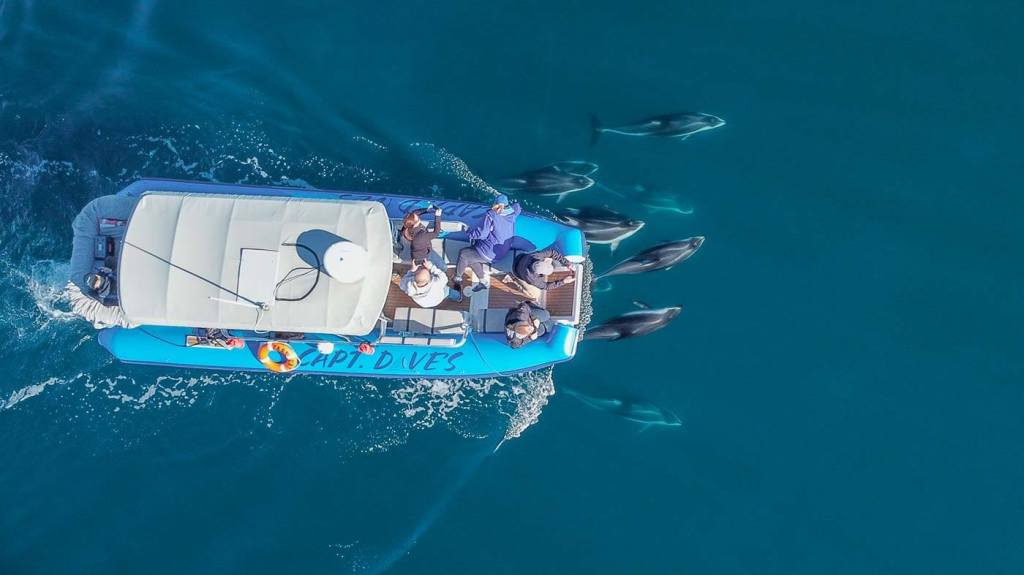10 Things That Are Amazing About Pacific White-Sided Dolphins

The Pacific white-sided dolphin has so many standout characteristics – we can’t wait to share with you “b-low! Often referred to as “Lags,” a shortened version of their scientific name Lagenorhynchus obliquidens, these vivacious and gregarious bi-colored oceanic dolphins have striking blackish grey and white markings and always wear a friendly smile you won’t forget. Passengers often see these 400-pound eight-foot swimmers as they curiously propel themselves towards the same direction as our boats. When they pop over for a visit, the onboard experience is unforgettable.
Top 10 amazing Pacific white-sided dolphin facts:
1. The Pacific white-sided dolphin are members of Odontocetes (toothed whales).
Remember, all dolphins are considered whales, while not all whales are considered dolphins. Three main characteristics help define this differentiation in species type:
- The presence of either baleen or teeth, which they each use to capture their prey.
- The number of blowholes they have.
- How they travel or migrate.
Odontocetes have teeth, only one blowhole, and have incredible family characteristics. This makes them unique to more giant rorqual whales in that they are all about protecting and growing their family and their family pod. In comparison, larger rorqual whales tend to see the word on their own or travel with only a couple of mates at one time.

2. Pacific white-sided dolphins are FAST!
There is no bad seat in the house when viewing Pacific white-sided dolphins out at sea! Known for reaching top speeds of up to 35mph, these spritely dolphins certainly have a pep in their step. These seven to eight-foot-long beauties often bow-ride or “porpoise” through the crest of the wave our stern-wake leaves behind our boat too. If you have ever wondered “where to go dolphin watching,” look no further! These sprinters are so much fun to watch zip through the sea. But, be sure to have your camera ready because these dolphins are sure to pull up on all sides of all of our boats to get a good look at you too.

3. The Pacific white-sided dolphin is a friendly face in the ocean.
Dolphins have a solid reputation for being playful, and these dolphins are quite possibly the friendliest of them all! Their inquisitive behavior and charming disposition are some of the reasons why the winter season makes for such a fun Dana Point whale watching experience. It is not unusual for these gregarious beauties to swim right up to the boat and turn over on their side and look up at you too. Now that is a dolphin connection for the memory book!

4. The Pacific white-sided dolphin is frequently seen in winter in Dana Point, CA.
Like most whales, the Pacific white-sided dolphin has a migration pattern that keeps
them in colder water ranging from North America to Asia. Lucky for us, they make a stop in Dana Point, California, the whale watching capital of the world®! Lags typically prefer deeper, colder water but beginning as early as November, they grace us with their presence closer to shore, and we have the opportunity to see them more frequently until the waters are warmer. Then they will head back out to the deep when April showers turn into May’s flowers in Southern California.
5. Pacific white-sided dolphins are unique!
Like Risso’s dolphins with their blunt snout, the Pacific white-sided dolphin has a similar facial look and feel. They have striking markings and unique coloring too. Their flanks are divided by a gorgeous white band that splits through their deep dark charcoal color on the top and bottom of each side, and when they turn over, you can see their underbelly is bright white. This unique shading also helps to keep them protected from lurking predators like Orca, who may be trying to spot them from above or below the surface. When looking up, their bright bellies mirror the sky’s reflection above the surface while the darker shading on their backs cast shadows, replicating the deep darkness below. This camo-like coloring is carried through into their dorsal fins as well. When seen at the surface, the Pacific white-sided dolphin dorsal fin is half white and half dark charcoal, making it the only dolphin to have such a colorful dorsal fin.
6. Pacific white-sided dolphins are family-centric!
Like most Odontecetes, these dolphins are all about family! It is not unusual to see 30-50 traveling together in what we call a pod. Traveling in pods helps to keep them safe from predators and care for younger, sick, or, injured family members. Pacific white-sided dolphins rely on one another to hunt and catch fish and share the day’s catch with their entire family. As with most dolphin pods, these dolphins also form matriarchal societies and will be connected with these pods for the duration of their whole life. The Pacific white-sided dolphin loves to frolic and socialize and is one of the friendliest of all the dolphin species. They are often seen with other cetaceans, including our local fin and humpback whales, Risso’s dolphins, common dolphins, and nearby cavorting sea lions
7. The Pacific white-sided dolphin is one of 49 different species of dolphins and porpoises!
That’s right! More dolphin species are out there than just those made famous on TV. Of the 49 total species, dolphins and porpoises are grouped into six families. The largest is the oceanic dolphin family consisting of 38 members. This group includes common dolphins, bottlenose dolphins, the Pacific white-sided dolphin, Risso’s dolphins, and killer whales, all of which can be seen right here in Dana Point, California, the Dolphin and Whale Watching Capital of the World®. With such variety among various dolphin species, this dolphin group is truly a standout. Like that of a Risso’s dolphin, these adorable dolphins also do not have a pronounced beak, contrary to their colorful common dolphin friends. Instead, the Pacific white-sided dolphin has more of a rounded blunt rostrum or snout.
8. The apex predator of the sea hunts Pacific white-sided dolphins.
No animal is safe in the ocean next to a mammal-eating orcas, more frequently known as the Bigg’s or transient orcas. These apex predators are ruthless when it comes to hunting marine mammals, and the Pacific white-sided dolphin is no exception. One of the best defense mechanisms built into the species is their ability to protect one another. Lags communicate with one another using their high-pitched whistles and contact interaction to set up the best barriers, hopefully keeping their families safe from the secretive prowl and attack of killer whales.
Sadly, it is not just transient orca who predates these fantastic animals. Sharks will also attack when the time is right. Because dolphins typically travel in pods, there is safety in numbers and 12-15 individuals traveling together sometimes keep sharks away, which could result in a deadly battle.
9. Pacific white-sided dolphins are sought after for large-scale aquatic zoo parks.
These highly intelligent and acrobatic animals are perfect candidates to be chosen for large-scale ocean aquariums. In captivity, they succumb to loneliness and sickness and are unlikely to reach the upper ends of their potential maximum of 40 years of age. Longline fishing nets also propose grave danger for these beautiful ocean animals.
If you are looking for a way to help protect these dolphins from land, try limiting or excluding fish from your diet. If you decide to consume fish, be sure to purchase from the USA as our fishing laws are more stringent here in the USA than other International laws. When dining out, be sure to check out Seafood Watch, produced by the Monterey Bay Aquarium. Their extensive list of safe seafood dining options is carefully reviewed so you can be sure that you are dining with chefs who care about dolphins and are doing what they can to protect these amazing creatures too!
10. The Pacific white-sided dolphin only uses teeth to grasp food, not chew!
If you are one of those people who isn’t the biggest fan of leftovers then you and our friendly Lags may have more in common than you think! Dinner is oftentimes a different item on the menu every day of the week for Pacific white-sided dolphins. They feed on a variety of other prey too. Some of their most delectable favorites include squid and small schooling fish (capelin, sardines, and herring), which tend to be featured highlights. Eating up to 20 pounds of food per day, these highly intelligent and social mammals work together to ensure that each individual in the pod has their fair share of the meal. Holding their breaths for more than 6 minutes at a time, they use their small conical teeth to help them catch and grip their prey before swallowing it whole, never using their teeth to chew their food.
Visiting Dana Point, California, the Whale Watching Capital of the World®, is the absolute best place to choose when booking a trip to catch a glimpse of Pacific white-sided dolphins. We can’t wait to show you all the ‘fintastic’ animals out here. Plus, you never know when they will come up to surprise you by capturing a good look at you too! So book a trip for your group on a private whale watching safari, or join us on an upcoming public trip today!

Until next time,
Jess Wright
First Mate and Marine Naturalist
Capt. Dave’s Dolphin & Whale Watching Safari
